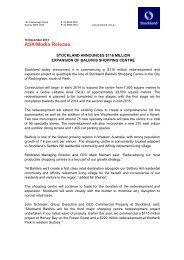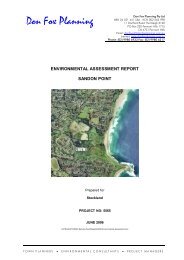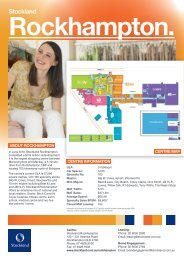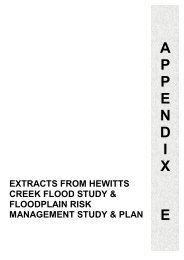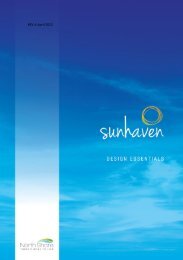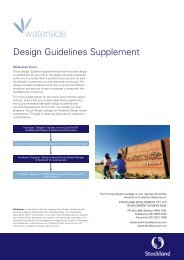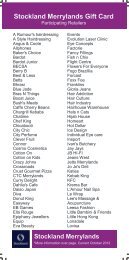SDOT2 Financial Report 30 June 2008 - Stockland
SDOT2 Financial Report 30 June 2008 - Stockland
SDOT2 Financial Report 30 June 2008 - Stockland
You also want an ePaper? Increase the reach of your titles
YUMPU automatically turns print PDFs into web optimized ePapers that Google loves.
Notes to<br />
the financial<br />
statements<br />
For the year ended <strong>30</strong> <strong>June</strong> 2007<br />
10 //<br />
1 Summary of significant accounting<br />
policies (continued)<br />
(h) Hedging (continued)<br />
Cash flow hedge<br />
A cash flow hedge is a hedge of the exposure to<br />
variability in cash flows attributable to a particular risk<br />
associated with an asset, liability or highly probable<br />
forecast transaction that could affect the Income<br />
Statement.<br />
The effective portion of changes in the fair value of<br />
derivatives that are designated and qualify as cash flow<br />
hedges is recognised in equity. The gain or loss relating<br />
to the ineffective portion is recognised immediately in<br />
the Income Statement.<br />
Amounts accumulated in equity are recognised in the<br />
Income Statement in the period when the hedged<br />
item is recognised in the Income Statement. When<br />
the forecast transaction that is hedged results in the<br />
recognition of a non-financial asset or a non-financial<br />
liability, the gains and losses previously in equity are<br />
transferred into the initial measurement of the cost of<br />
the asset or liability.<br />
Hedge accounting is discontinued when the hedging<br />
instrument expires or is sold, terminated or exercised,<br />
or no longer qualifies for hedge accounting. At that<br />
time, any cumulative gain or loss existing in equity at<br />
that time remains in equity and is recognised when<br />
the forecast transaction is ultimately recognised in<br />
the Income Statement. When a forecast transaction<br />
is no longer expected to occur, the cumulative gain<br />
or loss that was recognised in equity is recognised<br />
immediately in the Income Statement.<br />
Derivatives that do not qualify for hedge<br />
accounting<br />
Certain derivative instruments may not qualify for<br />
hedge accounting. Changes in the fair value of any<br />
derivative instrument that does not qualify for hedge<br />
accounting are recognised immediately in the Income<br />
Statement.<br />
(i) Finance costs<br />
Finance costs to external parties<br />
Finance costs to external parties include interest,<br />
amortisation of discounts or premiums relating to<br />
borrowings and amortisation of ancillary costs incurred<br />
in connection with the arrangement of loans and<br />
borrowings.<br />
Where interest rates are hedged, the finance costs are<br />
recognised net of any realised effect of the hedge.<br />
Finance costs to external parties are recognised as<br />
an expense in the Income Statement on an accruals<br />
basis, and if not paid at balance date are reflected in the<br />
Balance Sheet as a liability.<br />
(j) Cash and cash equivalents<br />
Cash and cash equivalents comprise cash balances<br />
and at call deposits. Bank overdrafts that are<br />
repayable on demand and form part of the Trust’s cash<br />
management are included as a component of cash<br />
and cash equivalents for the purpose of the Cash Flow<br />
Statement.<br />
(k) Impairment of assets<br />
The carrying amounts of the Trust’s assets are reviewed<br />
at each balance date, to determine whether there is any<br />
indication of impairment. If any such indication exists,<br />
the asset’s recoverable amount is estimated.<br />
An impairment loss is recognised whenever the<br />
carrying amount of an asset or its cash generating unit<br />
exceeds its recoverable amount. Impairment losses<br />
are recognised in the Income Statement, unless an<br />
asset has previously been revalued, in which case<br />
the impairment loss is recognised as a reversal to the<br />
extent of that previous revaluation with any excess<br />
impairment losses recognised through the Income<br />
Statement.<br />
Calculation of recoverable amount<br />
Impairment of receivables is not recognised until<br />
objective evidence is available that a loss event has<br />
occurred. Significant receivables are individually<br />
assessed for impairment. Non-significant receivables are<br />
not individually assessed. Instead, impairment testing<br />
is performed by placing non-significant receivables in<br />
portfolios of similar risk profiles, based on objective<br />
evidence from historical experience adjusted for any<br />
effects of conditions existing at each balance date.<br />
The recoverable amount of other assets is the greater<br />
of their fair value less costs to sell, and value in use.<br />
In assessing value in use, the estimated future cash<br />
flows are discounted to their present value using a<br />
pre-tax discount rate that reflects the current market<br />
assessment of the time value of money and the<br />
risks specific to the asset. For an asset that does<br />
not generate largely independent cash flows, the<br />
recoverable amount is determined for the cashgenerating<br />
unit to which the asset belongs.<br />
Reversals of impairment<br />
An impairment loss is reversed only to the extent<br />
that the asset’s carrying amount does not exceed the<br />
carrying amount that would have been determined,<br />
net of amortisation, if no impairment loss had been<br />
recognised.<br />
An impairment loss in respect of a held-to-maturity<br />
security or receivable carried at amortised cost is<br />
reversed if the subsequent increase in recoverable<br />
amount can be related objectively to an event occurring<br />
after the impairment loss was recognised.<br />
(l) Trade and other payables<br />
Other payables are stated at cost.<br />
Distributions to unitholders<br />
Distributions payable are recognised in the reporting<br />
period in which the distributions are declared,<br />
determined, or publicly recommended by the Directors<br />
on or before the end of the financial year, but not<br />
distributed at balance date.<br />
(m) Interest-bearing loans and borrowings<br />
Interest-bearing loans and borrowings are recognised<br />
initially at fair value less attributable transaction costs.<br />
Subsequent to initial recognition, interest-bearing loans<br />
and borrowings are stated at amortised cost with any<br />
difference between cost and redemption value being<br />
recognised in the Income Statement over the period<br />
of the borrowings on an effective interest basis unless<br />
there is an effective fair value hedge of the borrowings,<br />
then the borrowings are carried at fair value.<br />
(n) Provisions<br />
A provision is recognised when a present legal or<br />
constructive obligation exists as a result of a past event<br />
and it is probable that a future sacrifice of economic<br />
benefits will be required to settle the obligation, the<br />
timing or amount of which is uncertain.<br />
If the effect is material, provisions are determined<br />
by discounting the expected future cash flows at the<br />
rate that reflects current market assessments of the<br />
time value of money and, where appropriate, the risks<br />
specific to the liability.<br />
<strong>Stockland</strong> Direct Office Trust No.2 <strong>June</strong> 2007



